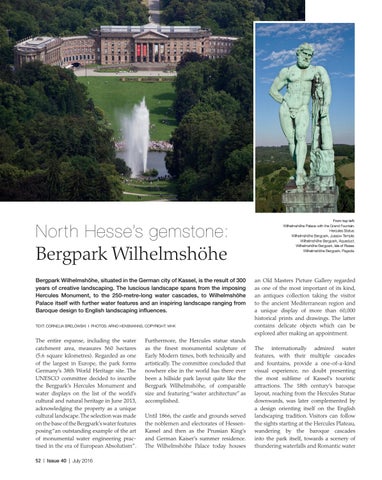North Hesse’s gemstone:
Bergpark Wilhelmshöhe
Bergpark Wilhelmshöhe, situated in the German city of Kassel, is the result of 300 years of creative landscaping. The luscious landscape spans from the imposing Hercules Monument, to the 250-metre-long water cascades, to Wilhelmshöhe Palace itself with further water features and an inspiring landscape ranging from Baroque design to English landscaping influences. TEXT: CORNELIA BRELOWSKI I PHOTOS: ARNO HENSMANNS, COPYRIGHT: MHK
The entire expanse, including the water catchment area, measures 560 hectares (5.6 square kilometres). Regarded as one of the largest in Europe, the park forms Germany’s 38th World Heritage site. The UNESCO committee decided to inscribe the Bergpark’s Hercules Monument and water displays on the list of the world’s cultural and natural heritage in June 2013, acknowledging the property as a unique cultural landscape. The selection was made on the base of the Bergpark’s water features posing “an outstanding example of the art of monumental water engineering practised in the era of European Absolutism”. 52 | Issue 40 | July 2016
Furthermore, the Hercules statue stands as the finest monumental sculpture of Early Modern times, both technically and artistically. The committee concluded that nowhere else in the world has there ever been a hillside park layout quite like the Bergpark Wilhelmshöhe, of comparable size and featuring “water architecture” as accomplished. Until 1866, the castle and grounds served the noblemen and electorates of HessenKassel and then as the Prussian King’s and German Kaiser’s summer residence. The Wilhelmshöhe Palace today houses
From top left: Wilhelmshöhe Palace with the Grand Fountain. Hercules Statue. Wilhelmshöhe Bergpark, Jussow Temple. Wilhelmshöhe Bergpark, Aqueduct. Wilhelmshöhe Bergpark, Isle of Roses. Wilhelmshöhe Bergpark, Pagoda.
an Old Masters Picture Gallery regarded as one of the most important of its kind, an antiques collection taking the visitor to the ancient Mediterranean region and a unique display of more than 60,000 historical prints and drawings. The latter contains delicate objects which can be explored after making an appointment. The internationally admired water features, with their multiple cascades and fountains, provide a one-of-a-kind visual experience, no doubt presenting the most sublime of Kassel’s touristic attractions. The 18th century’s baroque layout, reaching from the Hercules Statue downwards, was later complemented by a design orienting itself on the English landscaping tradition. Visitors can follow the sights starting at the Hercules Plateau, wandering by the baroque cascades into the park itself, towards a scenery of thundering waterfalls and Romantic water
